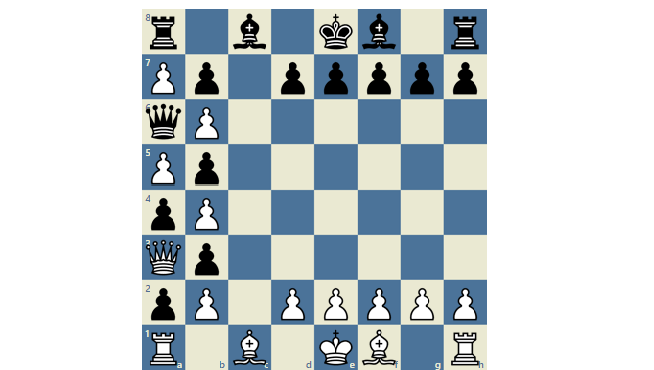
My First Custom Position Test - With an Interesting Analysis
Hello to all viewers of this post! Nearly a month ago, I created a custom position where both sides queens were trapped by a wall of the pawns and where there were no knights. I found the position interesting, because it had a few very big, simple goals that I tested out in the games I played in the position. This is my in depth analysis of the position that I created. The blog post will follow this format: first I show the position and explain it, then I show my games and say what I was thinking, and then I analyse the position with an engine to answer some of the questions I had with the position. Also, If someone else has already created this exact position before, I am sorry, but I thought of this position completely by myself. Ok, so to start, here is the position and here was what I was thinking when I created it:
1. I did not want any knights in the position, because I wanted the game about freeing the queens and not trying to take the trapped queens with the knights. This is why I did not include knights in the position.
2. The first and most obvious way to free your queen is by taking either the a2 or the a7 pawn depending on the color you are playing as with your rook. Then, the opponent could take the sacrificed rook and the opponents queen would have easy escape from the pawns, or the opponent would not take the rook, and it would take multiple moves for the opponent to free the queen which would definitely be an interesting solution
3. The next way to free your queen would be by taking on b3 or b6 depending on the color with the bishop. You would also want to defend these squares from this capture. Although it would take multiple moves to get the bishop to capture on these squares, the queen would be released and a bishop would be sacrificed instead of a rook like is stated in point #2, However, it might not be worse to sacrifice the rook because if one side sacrifices a bishop and the other a rook, the one that sacrificed the rook would have the advantage of the double bishops.
4. What I decided was best was to capture with my bishop and defend my opponent from doing the exact same thing.
Here is where all of my games in this position except for two can be seen. In one of those, my opponent timed out, and in the other that I am not showing, I made such a bad blunder that I was embarrased to post it here, but... IF AT LEAST 3 PEOPLE IN THE COMMENTS TELL ME TO POST THAT GAME, I MOST DEFINETLY WILL!!! So, moving on, I rematched my opponents in the same position after one game was done so that they could play as the other color, so for two of the users I played in this position, I played 2 games against them. Of the ones I have so far posted, I played as white 4 times and black 3 times. Here are all of my games in this position:
As can be seen by my games, I tried to use the bishop capturing method in every game that I played, and was for the most part, successful with it. I played e4 first and not e3, because I wanted to defend the square from which my opponent could sacrifice their bishop to free their queen. What I founf surprising was that nobody sacrificed their rook right from the beggining, because I think that if somebody did, I would have to sacrifice my rook as well, because then the sacrifice of my bishop would take too long, and my opponent could attack me while I was trying to do that or defend the square with their freed queen, Right now, I think I have learned that this position shows an example of setting goals in a chess game. Because the position does ot appear as complex as many chess positions, it is easier to come up with goals, and put them in action, which is important when playing chess. My overall score in these games was 5.5 points in the 7 games, which I expected since I came up with the position and already had plans for how I was going to play it. Now, up until this point, I have not analysed this position with an engine, and I have many questions to ask before I do the analysis. I will analyse this position to answer the following questions I have about my position:
5. If white after a selected opening of e4. followed by e5, decides to sacrifice the bishop to free the queen, then black does not try to free black's queen right away as well! I found this very surprising as now I thought it would be like white having an extra queen, but then one way black can play is to play the game by attacking b4 with the bishop and by not letting the white queen have many squares to go to with Rc8. White is still ahead after the bishop sacrifice though, but black does not NEED to try and free the black queen as well until later on in the game. Here is the diagram to explain my answer:
6. The final question. I thought when I played the computer that I was going to do the bishop sacrifice early and try to get my queen into the game early, but I was wrong. Black quickly stopped me from doing that, attacked me, and then got black's queen out which then resulted in a quick checkmate against me. Black's defense to my only plans was quick, and then I could not get my queen into the game. I was surprised by the huge attack I faced and then felt that going into the discovered check was my only option, which then caused black to cleverly free the queen, and once the queen was freed, I knew it was game over for me. The whole game I was trying to free my queen, and couldn't and with one discovered check, black did what I could not do in the entire game. I wanted to trade off the bishops so that I could sacrifice my rook to free my queen, but that never happened. Here is my game against the chess.com computer:
This position was very interesting for me overall because I was able to make goals and try to put them into action. Because the position was simple and had some attacking points right from the starting position, I was able to make conclusions about what could be done, and even though some of them, such as my rook theories for questions 1 and 2 were incorrect, I was still able to learn from this. I will probably be creating another position within the next month, but if viewers suggest me a position, I might use that instead, so if you have any positions you would like me to play and do an analysis of like this one, please send me them! Also, comment below if you liked this post and want me to do another position and also comment if you want me to reveal my game in this position that I didn't post here! (not the time-out game, the blunder game)
Thanks for reading this! Hope you learned from this position just like I did!

